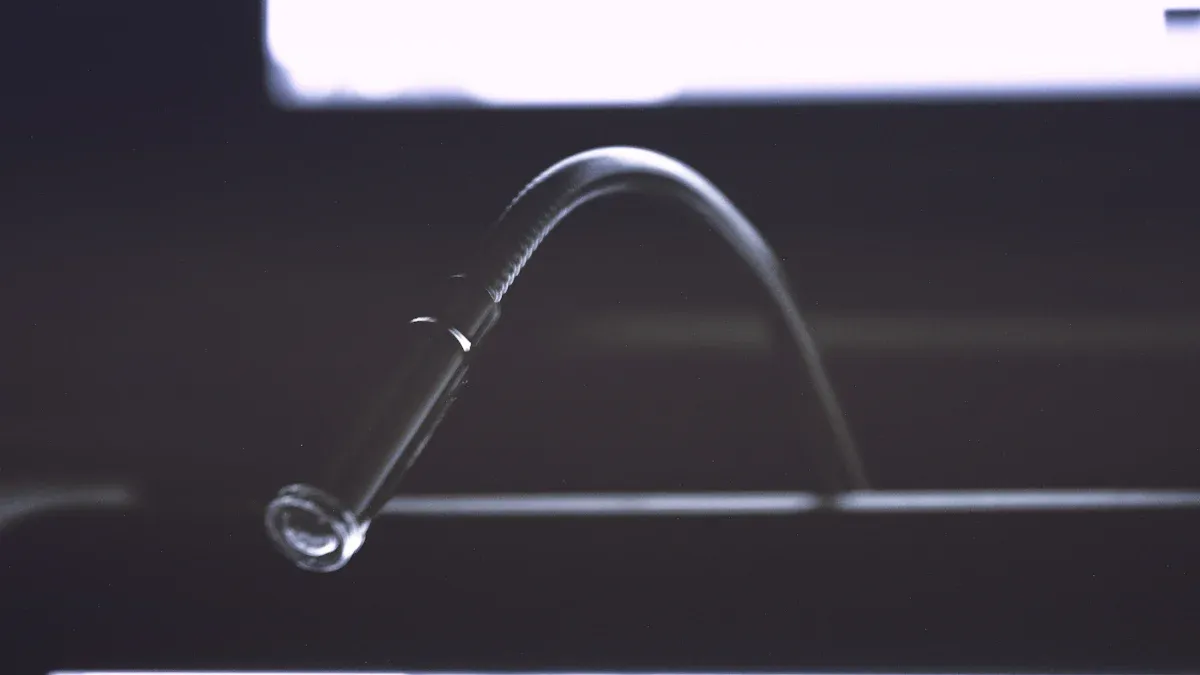How Micro-diameter PET Shrink Tubing Aids Endoscope Wiring

Micro-diameter PET shrink tubing for endoscope wiring offers critical advantages in modern medical devices. It ensures insulation, protects delicate wiring, and optimizes space within compact designs. Recent advancements demonstrate its impact on performance. For instance:
A clinical prototype falloposcope achieved all required specifications.
Laboratory testing confirmed its effectiveness in imaging tissue models.
The insertable portion's diameter was reduced to 0.8 mm, improving usability.
PET heat shrink tubing, paired with PEEK multilumen extrusion, enhanced durability and precision.
These innovations underline its importance in medical device manufacturing.
Key Takeaways
Thin PET shrink tubing covers and protects fragile wires in endoscopes. It helps the device work well during medical procedures.
This tubing keeps wires safe from water, chemicals, and other damage. It makes sure the wires stay strong and useful.
Its tiny size helps make endoscopes smaller and easier to use. Doctors can move them around more easily during procedures.
PET shrink tubing is tough and lasts through many cleanings. This makes it dependable for long-term use in hospitals.
PET tubing can be customized for different medical tools. This helps create new and better healthcare devices.
Understanding Micro-diameter PET Shrink Tubing

What is PET shrink tubing?
PET shrink tubing is a specialized form of heat shrink tubing made from polyethylene terephthalate (PET). It serves as a protective layer for wiring systems, offering insulation and mechanical support. Manufacturers design this tubing to shrink tightly around components when exposed to heat, ensuring a secure fit. Its lightweight and durable properties make it ideal for applications requiring precision, such as medical devices and electronics.
How does the shrinking mechanism work?
The shrinking process begins with the tubing being heated to a specific temperature. This heat activates the material's memory, causing it to contract and conform to the shape of the underlying component. The process ensures uniform coverage and eliminates gaps that could compromise insulation or protection. PET tubing's ability to shrink precisely makes it a preferred choice for intricate wiring systems, especially in compact designs like endoscopes.
Key features of micro-diameter PET shrink tubing
Micro-diameter PET shrink tubing offers several advantages that enhance its functionality:
Customization Options: Manufacturers provide tailored solutions with varying shrink ratios, thicknesses, and adhesive linings, ensuring compatibility with diverse applications.
Technological Advancements: Innovations such as flame-retardant and halogen-free tubing meet environmental standards and appeal to eco-conscious industries.
Continuous Improvements: Research and development efforts have improved temperature resistance, flexibility, and transparency, making the tubing more competitive in the market.
Demand in Electronics: The growing need for reliable insulation in electronic components has increased the popularity of PET tubing, particularly for its superior insulation properties.
Feature Description | Benefits |
|---|---|
Customization Options | Tailored shrink ratios and adhesive linings enhance effectiveness. |
Technological Advancements | Flame-retardant and halogen-free tubing meet environmental standards. |
Continuous Improvements | Enhanced temperature resistance and flexibility improve performance. |
Demand in Electronics | Reliable insulation drives adoption in electronic components. |
These features make micro-diameter PET shrink tubing indispensable for applications requiring precision, durability, and environmental compliance.
Applications in Endoscope Wiring

Insulation for delicate wiring systems
Endoscopes rely on intricate wiring systems to transmit signals and power their advanced imaging capabilities. These wires are often thin and fragile, making them susceptible to damage without proper insulation. Heat shrink tubing provides a robust solution by forming a protective layer around the wires. This layer prevents electrical interference and ensures consistent signal transmission.
Micro-diameter PET shrink tubing for endoscope wiring offers an additional advantage. Its precise fit minimizes the risk of gaps or loose coverage, which could compromise insulation. This feature is particularly important in medical applications, where reliability and accuracy are critical. By safeguarding delicate wiring systems, this tubing enhances the overall performance and longevity of endoscopic devices.
Tip: Proper insulation not only protects the wiring but also reduces the risk of device malfunctions during medical procedures.
Protection against environmental and mechanical stress
Endoscopes often operate in challenging environments, including exposure to bodily fluids, varying temperatures, and mechanical stress during insertion and removal. Heat shrink tubing acts as a shield, protecting the wiring from these external factors. Its resistance to moisture, chemicals, and abrasion ensures that the wires remain intact and functional.
Micro-diameter PET shrink tubing excels in this role due to its durability and high strength-to-weight ratio. It withstands repeated sterilization processes, a requirement for medical applications. Additionally, its ability to maintain structural integrity under mechanical stress makes it ideal for use in flexible and rigid endoscopes. This level of protection reduces the likelihood of device failure, contributing to patient safety and procedural success.
Space-saving benefits in compact designs
Modern endoscopes are becoming increasingly compact to improve patient comfort and procedural efficiency. This trend demands components that optimize space without compromising functionality. Heat shrink tubing addresses this challenge by providing a thin yet effective protective layer.
Micro-diameter PET shrink tubing for endoscope wiring takes this a step further. Its small diameter and precise shrinking capabilities allow it to fit snugly around wires, minimizing bulk. This space-saving design enables manufacturers to create slimmer endoscopes with enhanced maneuverability. The tubing's lightweight nature also reduces the overall weight of the device, making it easier for medical professionals to handle during procedures.
Note: The compact design of modern endoscopes would not be possible without advancements in materials like PET shrink tubing.
Material Advantages of PET in Medical Devices
High strength-to-weight ratio and durability
Polyethylene terephthalate (PET) stands out for its exceptional strength-to-weight ratio, making it an ideal material for medical-grade heat shrink tubing. Its lightweight nature ensures that it does not add unnecessary bulk to medical devices, while its strength provides robust protection for delicate wiring systems. This balance is particularly important in endoscopes, where compactness and durability are critical.
The durability of PET allows it to withstand repeated use in demanding environments. It resists wear and tear caused by mechanical stress, ensuring long-term reliability. This characteristic is vital for medical devices that undergo frequent handling and sterilization. PET's ability to maintain its structural integrity over time reduces the risk of device failure, enhancing patient safety and procedural success.
Tip: The high strength-to-weight ratio of PET not only improves device performance but also contributes to ergonomic designs that are easier for medical professionals to handle.
Resistance to chemicals, moisture, and heat
PET exhibits remarkable resistance to chemicals, moisture, and heat, making it a preferred choice for medical-grade heat shrink tubing. This resistance ensures that the tubing remains functional even when exposed to harsh conditions during medical procedures. For instance, PET does not degrade when in contact with bodily fluids or cleaning agents, preserving the integrity of the wiring it protects.
Laboratory tests confirm PET's resilience under various conditions:
Test | Description |
|---|---|
Evaluates thermal stability and decomposition characteristics of PET. | |
Chemical Compatibility Testing | Assesses PET's safety and integrity when in contact with various substances. |
Dynamic Mechanical Analysis (DMA) | Analyzes mechanical properties of PET across different temperatures and frequencies. |
These tests highlight PET's ability to endure extreme temperatures and chemical exposure without compromising its performance. This makes it an indispensable material for heat shrink tubing in medical applications, where reliability is non-negotiable.
Note: PET's resistance to moisture also prevents corrosion and electrical malfunctions, ensuring consistent device performance.
Compatibility with sterilization processes
Medical devices must undergo rigorous sterilization to meet hygiene standards. PET heat shrink tubing demonstrates excellent compatibility with standard sterilization methods, including gamma radiation and ethylene oxide. It retains its strength, flexibility, and structural integrity even after multiple sterilization cycles.
Comparative studies validate PET's performance in sterilization processes:
Evidence Description | Details |
|---|---|
Structural Integrity | PET tubing maintains its structural integrity post-sterilization, crucial for surgical reliability. |
Sterilization Methods | It is compatible with gamma rays and ethylene oxide, retaining strength and flexibility after cycles. |
Compliance with Standards | Meets ISO 17665-1:2023, ensuring it withstands high-temperature sterilization without degradation. |
This compatibility ensures that PET tubing meets the stringent requirements of medical-grade heat shrink applications. Its ability to endure sterilization without degradation makes it a reliable choice for medical devices, including endoscopes.
Callout: PET's compatibility with sterilization processes ensures that medical devices remain safe and effective for repeated use.
Compliance with Medical Standards
Biocompatibility and patient safety
Biocompatibility is a critical requirement for materials used in medical applications. PET heat shrink tubing meets stringent biocompatibility standards, ensuring it is safe for use in devices that come into contact with the human body. Regulatory frameworks such as USP Class VI and ISO 10993 establish rigorous testing protocols to confirm that materials do not cause adverse reactions. These tests evaluate systemic toxicity, irritation, and cytotoxicity, ensuring patient safety during medical procedures.
Regulatory Document | Description |
|---|---|
USP Class VI | Establishes biocompatibility testing for medical devices, requiring tests for systemic reactions. |
ISO 10993 | Defines biocompatibility standards for medical devices, categorizing body contact and exposure periods. |
FDA Title 21 | Regulates safety and effectiveness of medical devices, ensuring non-toxic materials are used. |
EU Regulation 1907/2006 | Addresses chemical substances to protect human health and the environment. |
The use of PET in heat shrink tubing ensures that medical-grade heat shrink products meet these biocompatibility requirements. This makes them suitable for applications where patient safety is paramount.
Note: Biocompatibility testing not only protects patients but also ensures compliance with global medical standards.
Adherence to FDA and ISO standards
PET heat shrink tubing complies with key regulatory standards, including FDA Title 21 and ISO 10993. These standards ensure that materials used in medical devices are safe, effective, and free from harmful substances. FDA approval is mandatory for medical devices sold in the United States, while ISO certifications provide a global benchmark for quality and safety.
Standard | Description |
|---|---|
ISO 10993 | Evaluates the biocompatibility of materials used in medical devices, ensuring no adverse reactions. |
USP Class VI | Certifies that the tubing is free from harmful chemicals and safe for prolonged medical use. |
FDA Approval | Ensures compliance with regulations for medical devices sold in the United States. |
Manufacturers of heat shrink tubing adhere to these standards to meet the demands of medical applications. This compliance guarantees that the tubing performs reliably under various conditions, including exposure to bodily fluids and sterilization processes.
Long-term reliability in medical environments
Medical devices often operate in challenging environments, requiring materials that can withstand repeated use and sterilization. PET heat shrink tubing excels in these conditions due to its durability and resistance to wear. Its ability to maintain structural integrity over time ensures long-term reliability, even in demanding medical applications.
The tubing's compatibility with sterilization methods, such as gamma radiation and ethylene oxide, further enhances its reliability. It retains its properties after multiple sterilization cycles, making it a dependable choice for medical-grade heat shrink products. This reliability reduces the risk of device failure, contributing to better patient outcomes and procedural success.
Callout: Long-term reliability is essential for medical devices, as it ensures consistent performance and patient safety.
Why AccuPath is the Preferred Choice
Expertise in precision-engineered medical components
AccuPath has established itself as a leader in precision-engineered medical components. Its innovative solutions cater to the demanding needs of the medical industry, ensuring reliability and performance. For example, the company’s expertise in PTFE liners with tie layers has revolutionized catheter manufacturing. These liners create a seamless bond, even in challenging applications, enhancing device durability.
Evidence Description | Quote |
|---|---|
Performance of PTFE Liners with Tie Layers | "The addition of a tie layer to PTFE liners ensures a seamless bond, even in the most demanding applications." |
Streamlined solutions for manufacturers | "For manufacturers who rely on PTFE liners, AccuPath’s approach offers a streamlined solution without compromising performance." |
Cost reduction in critical components | "AccuPath also offers tie layers as a solution to reduce costs and failure potential in critical catheter components." |
Reliability of medical devices | "Selecting the right PTFE Liner with Tie Layer is critical for ensuring the reliability of medical devices." |
This focus on precision and innovation allows AccuPath to deliver components that meet the highest industry standards, ensuring optimal performance in medical devices.
Customization for specific medical device needs
AccuPath excels in providing tailored solutions for medical device manufacturers. Its ability to customize components ensures compatibility with unique device designs. Whether it involves adjusting dimensions, materials, or performance characteristics, AccuPath works closely with clients to meet their specific requirements. This level of customization supports the development of advanced medical devices, such as endoscopes and catheters, that demand precision and reliability.
By offering bespoke solutions, AccuPath empowers manufacturers to innovate without compromising on quality. This adaptability has made the company a trusted partner in the medical device industry.
Commitment to quality and compliance
AccuPath prioritizes quality and regulatory compliance in every aspect of its operations. The company adheres to globally recognized certifications, ensuring its products meet stringent safety and performance standards.
ASTM F2063: Confirms that materials like nitinol tubing can perform reliably under demanding conditions.
ISO 13485: Focuses on quality management for medical devices, ensuring product safety and regulatory adherence.
These certifications validate AccuPath’s commitment to delivering dependable medical-grade components. By maintaining strict quality control processes, the company ensures its products consistently meet the needs of healthcare professionals and patients alike.
Callout: AccuPath’s dedication to quality and compliance not only builds trust but also drives innovation in the medical device industry.
Micro-diameter PET shrink tubing for endoscope wiring plays a vital role in enhancing device performance. Its ability to provide insulation, protection, and space optimization makes it indispensable in medical device manufacturing. These properties ensure that endoscopes meet the rigorous demands of modern medical procedures. AccuPath’s precision-engineered solutions further elevate the reliability of these components. By adhering to medical standards and driving innovation, AccuPath supports the development of advanced technologies that improve patient care and procedural success.
Tip: Choosing high-quality materials like PET shrink tubing ensures long-term reliability and compliance in medical applications.
FAQ
What makes PET shrink tubing suitable for medical devices?
PET shrink tubing offers durability, chemical resistance, and biocompatibility. These properties ensure it performs reliably in medical environments. Its compatibility with sterilization processes also makes it ideal for repeated use in medical devices like endoscopes.
Tip: Always verify that the tubing meets FDA and ISO standards for medical applications.
How does micro-diameter PET shrink tubing improve endoscope design?
Its small size and precise fit optimize space in compact devices. This allows manufacturers to create slimmer, more maneuverable endoscopes. The tubing also provides insulation and protection, enhancing device reliability during medical procedures.
Can PET shrink tubing withstand sterilization?
Yes, PET shrink tubing resists gamma radiation, ethylene oxide, and other sterilization methods. It retains its structural integrity and flexibility even after multiple cycles, ensuring long-term reliability in medical environments.
Is PET shrink tubing customizable for specific applications?
Manufacturers offer customization options, including varying shrink ratios, wall thicknesses, and adhesive linings. These features allow PET shrink tubing to meet the unique requirements of different medical devices.
Note: Customization ensures compatibility with advanced designs like flexible endoscopes.
Why is AccuPath a trusted provider of PET shrink tubing?
AccuPath specializes in precision-engineered medical components. The company offers tailored solutions, adheres to strict quality standards, and ensures compliance with FDA and ISO regulations. This commitment makes it a reliable partner for medical device manufacturers.
Callout: AccuPath’s expertise supports innovation in medical technology.
See Also
The Importance of Ultra-Thin PET Tubing in Healthcare Devices
Key Uses of Ultrathin PET Heat Shrink Tubing in Medicine
Enhancing Neurosurgical Catheters with FEP Shrink Tubing
Essential Insights on PET Heat Shrink Tubing for Electronics
Constructing Multi-Layer Catheters with Medical Grade FEP Tubing

